Andrea Hope, 2020
Introduction
The period from the mid to late 1800s was a pivotal time for the development of art in Melbourne, which was then known as Marvellous Melbourne.
Until the ‘crash’ in the 1890s, Melbourne was thriving as a result of the gold rush. (The population of Victoria at this time was just under one million, with about half that number living in Melbourne.)
The first railways were built in the 1850s and by the 1860s it was possible to travel from Melbourne to Richmond, Brighton, Hawthorn, Bendigo and Ballarat. As well, the first cable tram was operating along Flinders Street to Richmond by 1885. Within five years, trams were ferrying people between the city and inner suburbs along 65 kilometres of tram tracks[1]. Melbourne had the first telephone exchange in Australia and by 1887 there were approximately 8000 calls a day.

With increasing wealth, the city turned its attention to building cultural and educational institutions.
Melbourne University, which was established in 1853, began to admit women in 1880 (except in study of Medicine)[2].
The Public Library, now known as the State Library of Victoria, opened in Melbourne in 1859, and the National Gallery of Victoria opened in the 1860s, with the Government granting it the princely sum of £2000 to purchase art work. It was housed in the McArthur Gallery within the Library from 1875 and was the first gallery purpose built for paintings. The Gallery was immediately popular with early attendance figures of over 360,000 in its first year[3].
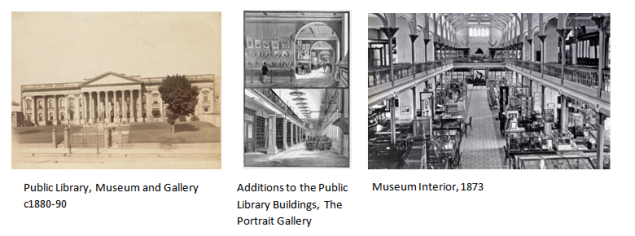
The National Gallery Art School, School of Design, accepted its first students in 1867 and in 1870 it split into two schools which were run as separate institutions.
Melbourne also hosted an International exhibition in 1880-1.
The tradition of modern international exhibitions had commenced in 1851, when London hosted two international exhibitions. This set off a hectic timetable with exhibitions held approximately every two years somewhere around the world until 1893[4].
The Great International Exhibition of 1880-1 was held at the Royal Exhibition Building in the Carlton Gardens. The exhibition included everything from works of art, furniture and accessories, and textiles to raw and manufactured products, agriculture and horticulture[5].
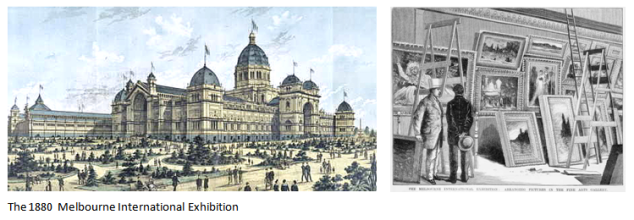
Private galleries and studios also began to appear. In upper Collins Street, from the GPO to Spring Street, there were art dealers, a framing store and Isaac Whitehead’s Gallery.

In 1885, Johnstone O’Shannessy opened his luxuriously furnished photographic salon in Collins Street and in 1888 the purpose-built artists’ studio complex, Grosvenor Chambers, which was the first in Australia, opened near the corner of Spring Street.
One-third of all the members of the Victorian Artists’ Society had their studios in this section of Collins Street. Tom Roberts created the most elaborate studio in the aesthetic style, drawing on Asian influences and decor and light wicker work[6].

The Victorian Academy of Art (VAA) which was established in 1870, offered schools for the study of fine arts and hosted annual exhibitions. It amalgamated with the Australian Artists Association (est. 1886) to form the Victorian Artists’ Society (VAS) in 1888.
As a result, more opportunities to study art became available, and there was an increasing interest in plein air painting, which contributed to Australia’s developing sense of nationalism. The ‘Heidleberg’ and other artists had greater opportunities to exhibit their work publicly, and wealthy patrons sought to have their portraits painted. Private art teachers travelled to and from Europe and Britain bringing with them new techniques and ideas.
Emma Minnie Boyd
Emma Minnie Boyd (1858 – 1936) was well placed to emerge as a highly professional and respected artist during this period, even though her achievements, like so many female artists of her time, were not celebrated into the future. Known as Minnie to distinguish her from her mother, also named Emma, she displayed an early talent.
She was a painter in oils and watercolours, a printmaker, sculptor, children’s book illustrator, ceramics painter and she made numerous sketches. One of her earliest works was an oil painting on a gum leaf (which was popular at that time[7]) Bush Scene, The Walk Chiltern area of North Eastern Victoria. In the early 1900s she also gave private art lessons.
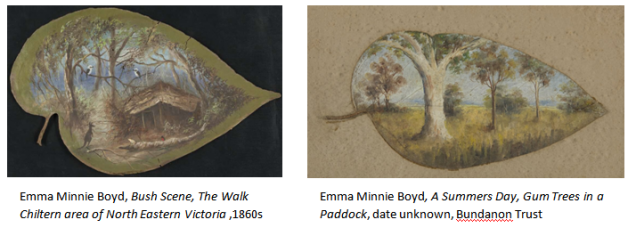
Artistically, Minnie may have inherited her skills from her great-uncle Thomas a’Beckett who was an accomplished amateur artist, and her father’s cousin Ted a’Beckett, who had trained at the Royal Academy in London and was a professional portrait painter.
Both her mother, Emma, and her grandfather, Sir William a’Beckett, the first Chief Justice of Victoria, were well known for their appreciation of the arts and they supported Minnie in developing her artistic talents. Emma hoped that ‘Minnie would make her mark [as a painter] in her time’[8].
Equally important was her family’s wealth, which enabled Minnie to train in drawing and painting both in Australia and overseas, and the opportunity to exhibit, without the need to earn a living or focus on finding a husband. Her grandfather, John Mills, had arrived in Australia as a convict but after he gained his ‘ticket of leave’ he became a successful brewer and property owner – and he left Emma very well off when he died when she was only three. The marriage of Emma to William a’Beckett provided the family with both wealth and status.
Education and Tuition
As a result, Emma was able to support her family’s endeavours and young Minnie was privileged to be able to attend a school for young ladies, where her lessons included drawing.
Although there is a perception that young Australian women had few options for eduction outside the home in the 19th Century, according to writer Majorie Theobold[9] there were at least 30 female schools in Victoria – aimed at the middle class and wealthy.
There are reports of Minnie Boyd attending two different schools. Dr Anne Sanders[10], Curatorial Researcher at the National Portrait Gallery, and Dr Anita Callaway[11] from the University of Sydney, report that she attended Madame Pfund’s school whilst the Boyd biographer, Brenda Niall reported that she attended Madam Vieusseux’s school[12].
Elise Pfund
In 1867 Swiss-born Madame Elise Pfund (1833–1921) established Oberwyl, a highly regarded private girls’ school in St Kilda. She ran the school until 1885, although it continued to operate until 1931. The school was named after her home village of Oberwyl in Switzerland, and the school gained a reputation for its French culture and style.

Oberwyl provided classes from kindergarten to senior secondary levels and attracted both day girls and borders. Classes were offered in arithmetic, reading, writing, spelling, elocution, history, geography, mapping, scripture, nature study, music, singing, drama, dancing, drawing, needlework, physical culture and tennis. Charitable work was an important part of the curriculum[13].
Together with her husband, architect and Victorian Surveyor-General, Elise Pfund was one of the important patrons of Heidleberg artists such Tom Roberts, who painted portraits of both Elise and her husband.
Julie Vieusseux
Brenda Niall wrote in her book, The Boyds, that Minnie had lessons at Madam Vieusseux’s school, where the ‘elegant, cultured and cosmopolitan’ principal set high standards in the teaching of art and French[14]. Marjorie Theobold states that the a’Beckett family were referees for the school when it began its formal existence in 1857[15], so it is likely that Boyd had some relationship with the school.

Madame Julie Vieusseux arrived in Australia in 1852 with her husband Lewis and their two small sons. They were among the thousands who migrated to Melbourne during the gold rush period.
Within a year she advertised “Drawing and Painting Classes for Young Ladies, who can enjoy the advantage of French conversation”[16].
In 1857, Vieusseux founded the Vieusseux Ladies’ College. Her school swiftly became a highly fashionable establishment, were the upper classes enrolled their daughters. In 1863, the school had 103 students, an unusually high number for an Australian school for girls.
Louis Buvelot 1814 – 1888
Around the late 1870s or early 1880s Minnie received private lessons from a leading artist in Melbourne, Louis Buvelot.

Buvelot was born in Switzerland and settled in Melbourne in 1865 at the age of 51, with his wife Caroline-Julie Beguin.
After first earning a living in Melbourne as a photographer the year they arrived, Buvelot was able to concentrate on his painting, whilst Beguin, also an artist, supported them by teaching French.
Bouvelot preferred to paint directly from nature or plein air, rather than painting exclusively in the studio from sketches. He work is likened to the French Barbizon school and is considered to be the beginning of Realism in Australia.
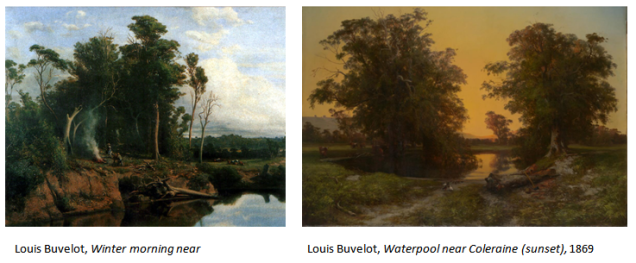
By 1869 Buvelot’s paintings Winter morning near Heidelberg and Summer afternoon, Templestowe had been purchased by the Board of Trustees of the Public Library, as part of the beginnings of an Australian Collection for the National Gallery. A year later the Trustees added his Waterpool near Coleraine (sunset) to this collection.
At this time Buvelot was teaching landscape drawing at the Carlton Artisans’ School of Design where he had a significant influence on the founders of the Heidelberg School.
Arthur Streeton, Tom Roberts and Frederick McCubbin acknowledged him as the father of Australian landscape painting[18]. McCubbin wrote: ‘There was no one before him to point out the way; he possessed, therefore, in himself, the genius to catch and understand the salient living features of the country. I remember as if it were yesterday, standing one evening a long time ago, watching the sunset glowing in the trees in Studley Park, and it was largely through Buvelot that I realized the beauty of the scene‘[19].
National Gallery School
In 1876, 1877, 1879 and 1882[20] Minnie attended the National Gallery School, which had only opened in 1867.
The Gallery School remained perhaps Australia’s most prestigious art education school, until its importance waned with the acceptance of modernism in the 1930s. Tuition at the school varied over the years, according to the interests of different teachers. Generally, however, classes followed the model of the European art academies. Students commenced their studies in the School of Design where they learnt the fundamentals of drawing, including outline drawing and tonal modelling of form. In the process they progressed from drawing plaster casts of antique sculptures to drawing from the human figure.
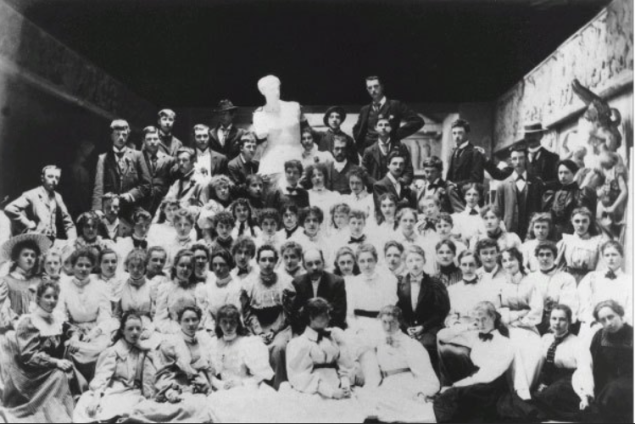
The School of Painting taught traditional painting skills. These included compositional skills and the academic technique of building up a painting in many layers, starting with thin paint and dark tones, and finishing with thicker paint and lighter tones on the surface[21].
Artists who were studying there during that period included Emanuel Phillips Fox, Rupert Bunny, Frederick McCubbin, Tom Roberts, May Vale, Jane Sutherland, Clara Southern, Josephine Muntz Adams and Arthur Merric Boyd, who was to become Minnie’s husband in 1886.
Eugène von Guérard 1811- 1901
Eugène von Guérard tutored Minnie in painting in 1876 and 1879. He had been appointed master of the National Gallery of Victoria School of Art (painting) and inaugural curator of its collection in 1870.

Born in Vienna and trained in the German Romantic tradition, which suggested the presence of divine powers in nature, he was one of a number of artists who came to Australia attracted by the discovery of gold.
He arrived in Australia in 1852 and spent about two years prospecting near Ballarat before moving to Melbourne, where he established himself as an artist. He gained a reputation for his landscapes and homestead portraits, and also for his wilderness subjects of waterfalls and mountains[22].

Although he was criticised for his outmoded techniques as a teacher, which restricted students to copying artworks in the gallery’s collection,[23] Minnie Boyd must have seen value in his style as she was under his tutelage for two years. She was also tutored by George Folingsby in painting and Oswald Rose Campbell in drawing whilst at the Gallery School.
Minnie had a solid grounding in the fundamentals in drawing, combined with skills in both the mediums of oil and watercolour. Like many artists of the time, Minnie had kept a sketchbook from the mid 1870s and her first sketchbook, from 1874-1878, contains over 50 small and detailed drawings primarily relating to her home, the surrounding district and her family, friends and pets.

Exhibitions
Minnie began exhibiting publicly as an amateur, at the age of 15, at the fourth VAA exhibition in 1874, with An Afternoon Nap, a watercolour of her mother asleep on a chaise lounge on their drawing room. In the same year she painted a watercolour of her home, The Grange.
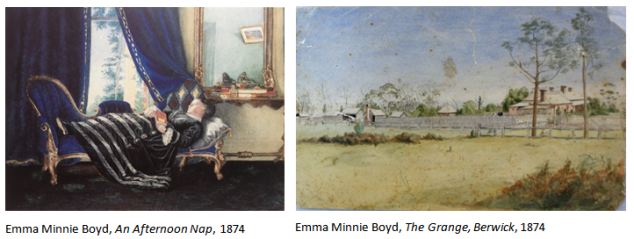
Interior genre scenes were typical of her work at the time – depicting family and friends. These paintings of a leisurely lifestyle were often set against a backdrop of a window or door, inviting the viewer to become part of the scene. Even these early works demonstrate not only her painting and composition abilities, but also her understanding of light and shadow.
She also painted a series of botanic and still life works.
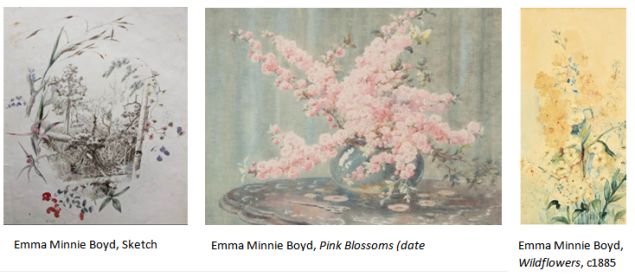
Although as a young single woman she didn’t travel in the same way as the male Heidelberg painters, many of whom she knew, she painted many landscapes during her career, initially around her country home in the hills of Parkaway, east of Melbourne, and then later on holiday in Tasmania, overseas in Britain and Europe and then again around the outskirts of Melbourne from the 1890s.

By 1877 her status had changed from amateur to professional and in the following year three of her six oils and watercolours were exhibited with prices ranging from £6/6/0 for a watercolour drawing to £7/7/0 for the oil paintings and in 1879 her watercolour, Reaping, was one of the highest prices of all the watercolours at that exhibition [24]. By 1889 the asking price for her oil painting, The Letter, of £32 was comparable with the prices being asked for by Frederick McCubbin and Arthur Streeton at the same exhibition, given the size of her work which was only 60 x 40 cm.[25]
 She also exhibited at Buxton’s Art Gallery on several occasions, the same gallery where the famous 9 x 5 Impressionist exhibition was held in 1887. (Interestingly, in his paper, Arabesques of Beauty: Cullis Hill, the 9 by 5 Impression Exhibition, decorative decor and painting[26], Andrew Montana uses Minnie’s painting, Corner of a Drawing-Room, 1887, to demonstrate the ambience that the artists were aiming to achieve for the exhibition.)
She also exhibited at Buxton’s Art Gallery on several occasions, the same gallery where the famous 9 x 5 Impressionist exhibition was held in 1887. (Interestingly, in his paper, Arabesques of Beauty: Cullis Hill, the 9 by 5 Impression Exhibition, decorative decor and painting[26], Andrew Montana uses Minnie’s painting, Corner of a Drawing-Room, 1887, to demonstrate the ambience that the artists were aiming to achieve for the exhibition.)
Minnie herself was not interested in contributing to this exhibition, as her style was not Impressionistic, although she would have known the artists who had studied at the Gallery School whilst she was enrolled.
Minnie also contributed to the Victorian Jubilee Exhibition in 1884 and the Melbourne Centennial International Exhibition of 1888-89.
She also sent two painting to English exhibitions – the Colonial and Indian Exhibition, London in 1886 and the Exhibition of Australian Art, London, in 1898. The artists contributing to the Exhibition of Australian Art, including both Emma and her husband Arthur Boyd (whom she’d married in 1886), reads like a ‘who’s who’ of leading Australian male and female painters of the time[27].
By the late 1880s she and Arthur were also working from a studio in Collins Street.
Children’s Book Illustrations
Minnie and Arthur spent a number of their holidays in Tasmania, where she also exhibited her paintings, and it is possible that she met children’s author and illustrator Louisa Anne Meredith there around 1889-89. Minnie was invited to prepare a number of illustrations for Meredith’s book, Waratah Rhymes.
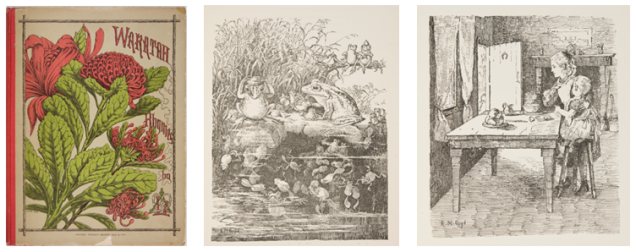
She also painted three watercolours for the story The Light on Goat Island written by Mary Gaunt and published in Childhood in bud and blossom : a souvenir book of the Children’s Hospital bazaar in 1900[28].
Europe
In 1890 Minnie and Arthur travelled to Britain and Europe, arriving firstly at Brindisi near the southern tip of Italy, where they made their way to England sketching and painting en route, and finally making their base at the family home of Penleigh House in Wiltshire (about a three hours train trip to London) where her parents were already living.

Whilst in England the Royal Academy in London accepted a painting by Minnie, To the Workhouse. for an exhibition in 1891.
Minnie’s mother Emma purchased To the Workhouse, and gifted it to the National Gallery of Victoria, which currently holds five of her paintings.
She also produced at least one etching while in Britain, Hiker leaving hillside village, in 1892.
At the same time Minnie was learning to paint small works in black and white from Henry Blackburn, the editor of London Society, who had a strong reputation for his illustrations. However, from about this time, the majority of her paintings were watercolours, which may have been because they were quick and easy to execute during the period when she had a growing family.
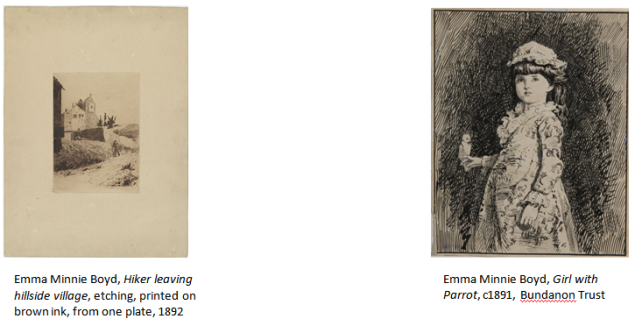
In 1892 she also had paintings included in an exhibition in Bristol before leaving France for Italy in 1893 and then Lucerne in Switzerland (where their fourth child, Martin, was born).
Return to Melbourne
The land crash of 1893 in Melbourne meant that her parents income was halved[29], and the family chose to return to Australia, with Minnie and Arthur arriving in 1894.
The end of “Marvellous” Melbourne spelt the end of a leisurely lifestyle, but nonetheless both Minnie and Arthur were able to continue as artists, assisted by her mother who was still able to provide financial support.
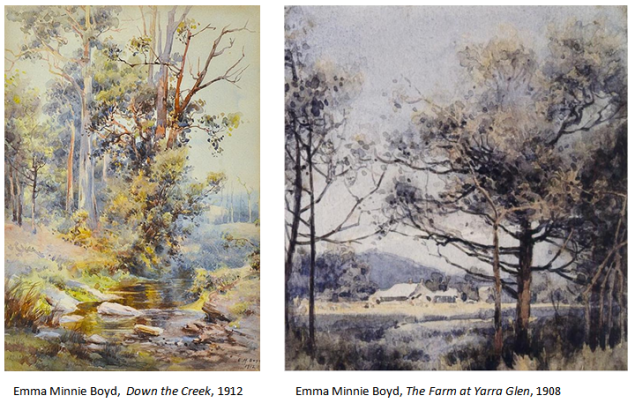
To supplement their income, Minnie taught art to students in her city studio in the Cromwell buildings (owned by her mother), whilst also continuing to exhibit to the Victorian Artists Society – displaying a number of paintings from the travel abroad.
In 1902 Minnie and Arthur held a joint exhibition at the grand home of Como in Toorak, owned by their friends Caroline and Charles Armytage – where they were lauded as being ‘amongst the best of Australian artists‘[30]. They sold over £100 of paintings and were offered a number of commissions. At that time it was most unusual for artists to hold independent exhibitions, most artists exhibited more formally in groups.
in 1908, the Boyds later purchased a farm at Yarra Glen, with the inheritance Minnie received following Emma’s death.
Minnie’s first Yarra Glen landscapes soon appeared in the Victorian Artists Society exhibitions. At this time her paintings were mostly small watercolours which were moderately priced at around the four or five guinea mark.
Paintings in her later years also included fewer figures – they were mainly landscapes, at which she was particularly adept. She was also fortunate to live rurally and close to the sea, enabling her to easily find subjects for her paintings.
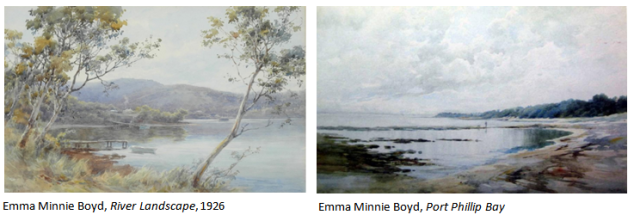
Some observations about the Emma Minnie Boyd’s art
Minnie Boyd worked as a professional artist, who clearly not only took every opportunity to develop her skills through formal studies and tutelage, but also to test her abilities in a range of media – although she is best known for her watercolours. Not an easy medium to excel in, it can be worked with quickly, unlike oil painting, and this may have been important to her at the time when she became a parent.
She displayed an early talent, exhibiting her first painting in 1874, with her last entry in an exhibition in 1932 – just 4 years before her death.
Minnie’s subject matter included domestic scenes, portraiture, still life, buildings and landscapes. Early in her career her focus was genre painting (painting of scenes from everyday life) with landscapes being favoured particularly after her return from Europe in the 1990s. Some early paintings also have some narrative – such as Ere Care Begins, 1887 and To the Workhouse, 1891, but her later works are more picturesque – views of the rivers, sea and rural areas in the areas where she lived.
Exhibiting and selling her work was important to her, and in the early 1890s her mother wrote, “Minnie [is] doing some trees, she likes doing them and Arthur says they sell better than other pictures“[31].
Minnie had a strong sense of composition – her paintings lead you in and around a scene, with a number of interesting points to hold your attention. Her genre paintings have attracted a great deal of interest because of their detail, for example, Corner of a Drawing Room, 1887 (below left). The curved archway, painted in an off-white, with the light shining through, leads you into an intimate space where you feel the family could re-gather at any time. It looks homely, domestic and also appealing, particularly with the drawn curtains that invite you outside. The touches in the scene, chairs, footstools, cushions, ceiling and wall motifs, flowers and artefacts, all give you a sense of time and place in Melbourne. It’s a very restful, well executed oil painting.
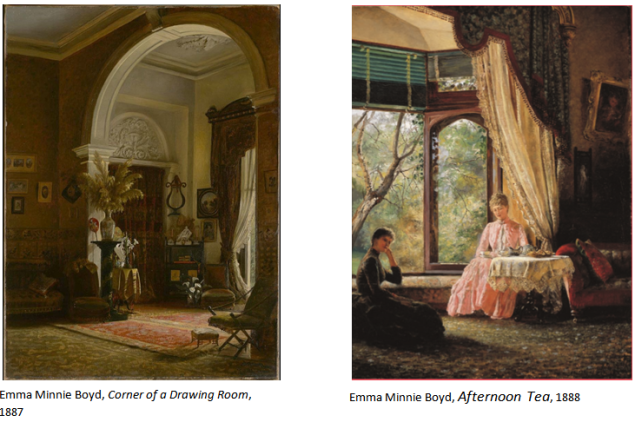
Afternoon Tea, painted a year later in 1888, is a painting of two women in another domestic setting. This painting has also made good use of the light flowing through the window, although there is less detail in this work.
The figures in the painting appear to be posed in quiet contemplation and there is no indication of imminent movement. (Unlike Minnie’s own busy life I find these women represent the enforced idleness of many middle and upper class women of the time.)
Yet some of Minnie’s portraits are show a greater sense of character, including a self portrait painted in 1912.
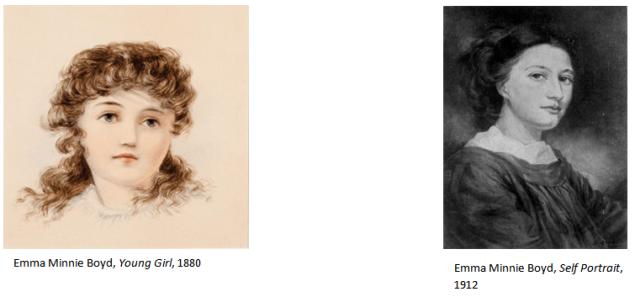
Although I haven’t found many examples of her still life and botanical pictures, they are well executed. For example, her flower studies from the 1870s and Flowerpiece (date unknown but after 1886).
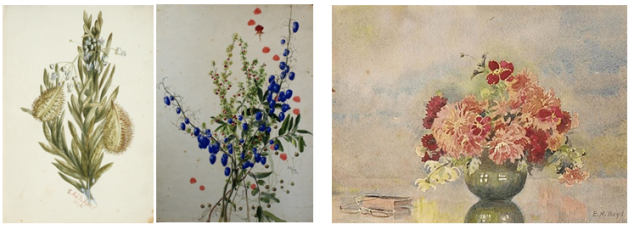
The first study appears to be painted in 1873 (the date is a bit unclear) when Minnie would have been just 15, the second shows and increasing confidence and skill. The Flowerpiece clearly shows a strong development in her work – very carefully composed in an Impressionist style – it’s a very arresting and peaceful work. It’s made more appealing by the simple addition of the book and glasses to the left, and the added touches of the scattered light red flowers – just enough to lift and brighten the work.
Like many professional artists, Minnie was highly proficient in drawing, having kept sketchbooks since she was a teenager, drawing botanical works and later contributing illustrations for at least one children’s book.
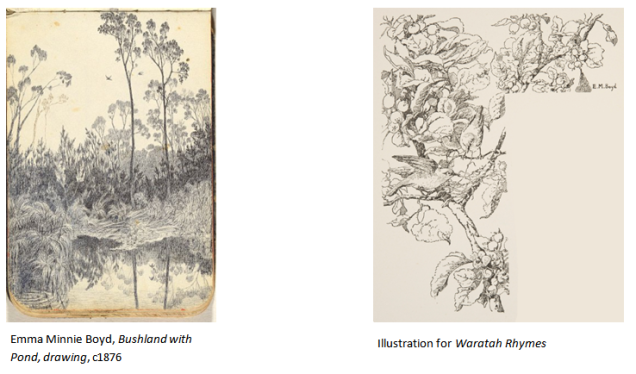
Four of her works that I am particularly drawn to are A Bush Camp, c1870s, Doris Boyd sketching on the Yarra River, 1914, Fallen Tree (date unknown) and In Lucerne, 1893.
These four works span a 40 year period of her career, the first in oil and the others in watercolour.

Bush Camp was painted during the 1870s, when Minnie was probably still in her teens. It has quite an Impressionistic style, at the time when Impressionism was reaching its peak in Europe. The brushstrokes are quite broad and flat, with wonderful light coming into the picture, and the shadows are painted in deep mauve, not black or grey.

It has a slight ‘Heidelberg’ quality about it because of its subject, although it was painted the decade before Tom Roberts painted An Artists Camp in 1886 . (In Roberts’ painting I think that the pose of the sitting figure isn’t quite right – it looks awkward.)

The second painting, Doris Boyd sketching on the Yarra River, was painted in 1914 when Minnie was living at Yarra Glen with her family. Doris, her daughter in law, was also an artist. I find this pose more natural than some of her earlier figures, and the light colour of her dress takes you right into the picture, taking in all the painter’s equipment. The boot protruding from the skirt, painted in a similar colour to the hat, make the picture complete. It’s an idyllic painting of a person sitting in the sunshine absorbed in what they are doing.

Fallen Tree is a typical Australian rural painting for its era – immediately recognisable and comfortable for any-one who had lived in similar countryside. It’s a well composed painting, taken from a low vantage point, looking up to the majestic gum trees, the homestead with its chimney smoke and the mountains in the distance. There is a lovely device of the slightly darker and flatter grass that leads, like a meandering path, from the bottom right through to what could be a creek, then towards the centre and slightly left towards the house. The clouds are suggestive of rain that may have just moved through, with the sun now re-emerging. Overall, it’s very picturesque, and Minnie painted many other landscapes with the same careful composition which places us squarely in an Australian setting.

I really enjoy the modern-ness of Minnie’s painting, In Lucerne, painted in Switzerland in 1893 shortly before she returned to Australia. The simple wash, with a limited palette, but a splash of red on the stall, gives it a simplicity which works with the subject matter. You can see how again Minnie is using the winding street to lead us from the front bottom left through to the centre of the picture, and the vertical proportions appear to be equal to the ‘golden ratio’.
Achievements
Emma Minnie Boyd was one of the few women who was able to combine her profession as an artist with marriage and a family, while at the same time holding a strong religious ethic and devotion to charitable works.
She was able to achieve this, not only as a result of her talent and commitment, but also because she was born into a family with a strong interest in art who could afford to support not only her herself and her family during her lifetime. Her husband, Arthur Merric Boyd, also an artist, put no obstacles in her way and they painted and exhibited together. For most of her married life, she also had some assistance in caring for her children and maintaining her home (although she was certainly active in these activities).
She was fortunate to be born at the time that Melbourne was expanding rapidly, where she had access to private education, tuition at the Gallery School and the ability to regularly show her work at numerous exhibitions, initially as an amateur and then professionally, both in Australia and Britain. She was also fortunate to be painting at a time of growing nationalism, with other well known artists from the ‘golden’ period of plein air painting.
A prodigious artist, she entered her work in many exhibitions and received numerous art awards, sold her paintings profitably and her work has been acquired by a number of state and regional galleries as well as the National Gallery of Australia.
Andrea Hope
Kiama Art Gallery
You’ll find the full article, together with the Bibliography, on my Australian Art History Website
https://www.australianarthistory.com/
[1] Museums Victoria, Marvellous Melbourne, https://museumsvictoria.com.au/longform/marvellous-melbourne/
[2] Melbourne International Exhibition 1880,
Official catalogue of the Exhibition, Volume One http://handle.slv.vic.gov.au/10381/298690, p48
[3] Lisanne Gibson, The uses of art, University of Queensland Press ,St Lucia, Qld, 2001, p32
[4] Louise Douglas, Representing colonial Australia at British, American and European international exhibitions, The National Museum of Australia’s journal reCollections (March 2008, Vol 3 No 1).
[5] Melbourne International Exhibition 1880, Official catalogue of the Exhibition, Volume One http://handle.slv.vic.gov.au/10381/298690
[6] Dr Anne Sanders, Less than Six Degrees of Separation, Lecture, 28 May 2011, National Portrait Gallery, Australia
[7] National Library of Australia, Picturing Australia, 2009, p70
[8] Brenda Niall, Life class: biographer of the Boyds, Brenda Niall considers the role of the Victorian Gallery School in their careers. (Essay). Meanjin, June 2003, p. 120+
[9] Marjorie Theobald, Boundaries, Bridges, and the History of Education: An Australian Response to Maxine Schwartz Seller. History of Education Quarterly, vol. 33, no. 4, 1993, pp. 497–510, p502
[10] Dr Anne Sanders
[11] Anita Callaway, Emma Minnie Boyd, Design & Art Australia Online, https://www.daao.org.au/bio/emma-minnie-boyd/biography/, 1995
[12] Brenda Niall, The Boyds, Melbourne University Press, 2002 p57
[13] Edel Wignall, Christina’s Matilda, Interactive Publications, 2011
[14] Brenda Niall, The Boyds, p57
[15] Marjorie Theobold, Knowing Women: Origins of Women’s Education in Nineteenth-century Australia, Cambridge University Press, 1966, p45
[16] Marjorie Theobald, Boundaries, Bridges, and the History of Education, p 504
[17] Marjorie Tipping, Eugène von Guérard’s Australian Landscapes, 1st ed, Lansdowne Press, Melbourne, 1975.
[18] Ella Fry, Gallery Images, St George Books, Perth, 1984
[19] William Moore, The Art of Frederick McCubbin, Melbourne, 1916, quoted in The Story of Australian Art, Angus and Robertson, Sydney, 1934
[20] Jane Alexander, Emma Minnie Boyd 1858 – 1936, Morning Peninsula Regional Gallery, exhibition curator, c2004, p8.
[21]National Gallery of Victoria, Australian Impressionism, https://www.ngv.vic.gov.au/australianimpressionism/education/insights_artistic.html
[22] National Gallery of Australia, Eugene von Guerard: ‘Purrumbete from across the lake, 1858’, ABC Education
[23] https://www.artgallery.nsw.gov.au/collection/artists/von-guerard-eugene/
[24] Jane Alexander, p9.
[25] Jane Alexander, p17
[26] Andrew Montana, Arabesques of Beauty: Cullis Hill, the 9 by 5 Impression Exhibition, decorative decor and painting, State Library of Victoria, https://www.slv.vic.gov.au/sites/default/files/La-Trobe-Journal-%2093-94-Andrew-Montana.pdf
[27] Exhibition of Australian art in London : Grafton Galleries, Grafton Street, London, W., 2nd April to 7th May, 189, National Library of Australia https://nla.gov.au/nla.obj-52857935/view?partId=nla.obj-102528494
[28]Jane Alexander, p 20
[29] Martin Boyd, A Single Flame, Dent & Sons Limited, 1939, p6.
[30] Jane Alexander, p21
[31] Brenda Niall, The Boyds, p103.
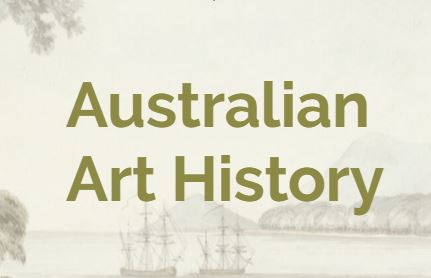
Andrea, greetings! Thank you so much for your splendid article on Emma Minnie Boyd, so full of information, branching out into fascinating contexts, and beautifully illustrated. You give the very kind of enjoyment we all need just now. All best wishes, Roy.
Thanks so much Roy, I’ve really enjoyed the research.
Thank-you. That was a fabulous read. I learnt more about her in 20 minutes than i could have anywhere else. It was so interesting to read that she had artistic family members in generations preceding her. She seems to have been one of the lucky ones – born with a creative ability, encouraged by those around her, taught by great artists and marrying a man who believed that she should practise and explore her art as he did. And because of this we have her art, including her brilliant landscapes, and that of the artistic family that she and her husband raised and nurtured.She also lost two children to premature deaths. I suspect that she she may have given it all up to have her two children back. Thank-you again. Colin
Hi Colin, thanks so much for your two wonderful books on the Boyds – Lucy Boyd Beck, Life and Art, by Colin G Smith and Merric Boyd and Murrumbeena, the Life of an Artist in a Time and a Place, by Colin G smith
its a pleasure.pls enjoy. all the best, colin
Andrea thankyou for sharing your knowledge of Emma Minnie Boyd. I have a painting that is attributed to her; an early painting on a gum leaf
I’ll keep your article with the painting now